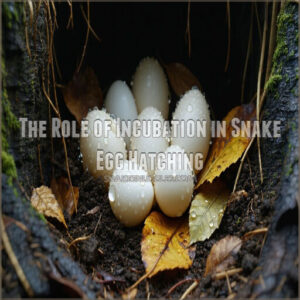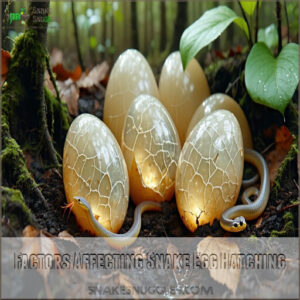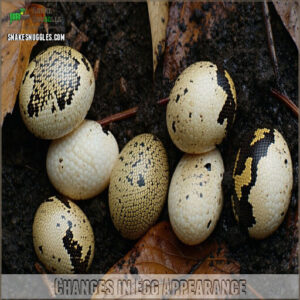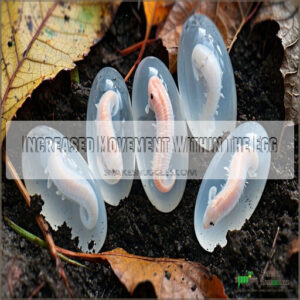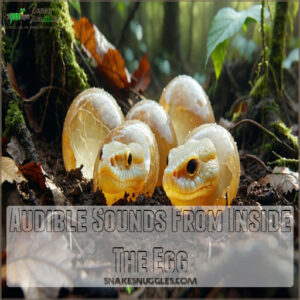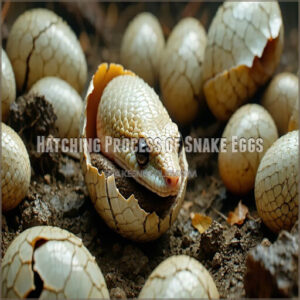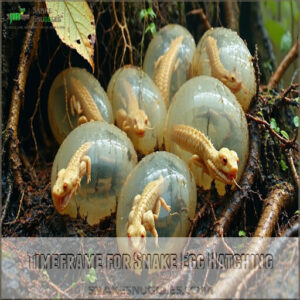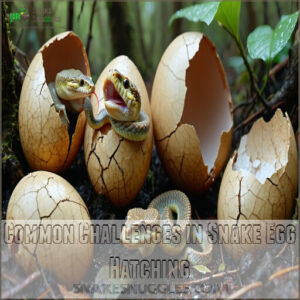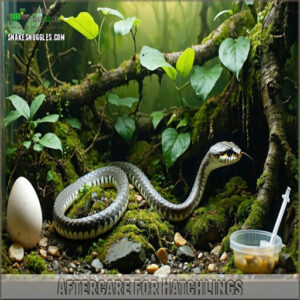This site is supported by our readers. We may earn a commission, at no cost to you, if you purchase through links.
 Snake eggs hatch when the baby snakes, called hatchlings, use a tiny, specialized tooth known as an egg tooth to cut through their leathery shells in a process called pipping.
Snake eggs hatch when the baby snakes, called hatchlings, use a tiny, specialized tooth known as an egg tooth to cut through their leathery shells in a process called pipping.
This can take up to 48 hours. During incubation, keeping the eggs at 27–31°C (80–88°F) with about 90% humidity is essential for healthy development.
Embryos feed on the yolk inside the egg until they’re ready to emerge. Proper ventilation and gentle handling (no flipping!) help make sure success.
Signs like faint sounds, movement, or changes in the shell mean hatching is near. Curious about what happens after they emerge? Stick around!
Table Of Contents
- Key Takeaways
- Snake Egg Hatching Process
- The Role of Incubation in Snake Egg Hatching
- Factors Affecting Snake Egg Hatching
- Signs of Imminent Snake Egg Hatching
- Hatching Process of Snake Eggs
- Timeframe for Snake Egg Hatching
- Care and Monitoring During Snake Egg Hatching
- Common Challenges in Snake Egg Hatching
- Aftercare for Hatchlings
- Celebrating The Successful Hatching of Snake Eggs
- Frequently Asked Questions (FAQs)
- Can snake eggs hatch without an incubator?
- How many snakes are in one egg?
- What to do if you find snake eggs in your yard?
- Do snakes leave their eggs after laying them?
- How do snakes hatch?
- What happens when a baby snake hatches?
- How long do snake eggs hatch?
- How does incubation affect snake egg hatching?
- How do snakes lay eggs?
- Why do snake eggs hatch more quickly?
- Conclusion
Key Takeaways
- Keep snake eggs at 27–31°C (80–88°F) with 90% humidity for healthy development during incubation.
- Hatchlings use an egg tooth to break through their leathery shells in a process called pipping, which can take up to 48 hours.
- Watch for signs like egg dimpling, movement, or faint sounds to know hatching is near.
- Once hatched, provide a warm, humid enclosure and minimal handling to help hatchlings adjust.
Snake Egg Hatching Process
Every snake egg tells a fascinating story of new life.
During the snake egg hatching process, snake embryos develop inside leathery shells, usually nestled under logs or in warm earth.
Inside, they feed on nutrient-rich yolk while growing stronger each day.
When it’s time, the baby snake uses its specialized egg tooth to make its grand entrance – a process called pipping.
Think of it as nature’s version of a baby’s first steps!
Within 48 hours, most of the clutch emerges, ready to start their independent journey in the wild.
The Role of Incubation in Snake Egg Hatching
Through careful incubation, you’ll create the perfect environment for snake eggs to develop into healthy hatchlings.
Think of it as setting up a cozy nursery where temperature and humidity work together to support life.
Female snake health is essential for successful snake egg incubation.
Key elements for successful snake egg incubation:
- Maintain temperatures between 27-31°C (80-88°F) for ideal embryo development
- Keep humidity levels around 90% using a reliable incubation system
- Make sure proper ventilation without drying out the eggs
- Monitor egg position daily, but avoid unnecessary handling
The incubation period typically lasts 45-70 days, varying by species.
With patience and attention to detail, you’ll master the art of incubation.
Factors Affecting Snake Egg Hatching
You’ll find that successful snake egg hatching depends on three key factors: temperature, humidity, and oxygen levels.
If you’re hoping to see healthy snake babies emerge, you’ll need to maintain ideal conditions of 27-31°C with 90% humidity while ensuring proper airflow throughout the incubation period.
Temperature and Humidity
Incubation brings us to the heart of successful snake breeding: temperature and humidity control.
You’ll need steady heat control and proper humidity levels to help those precious eggs develop.
For most snake species, keeping temperatures between 78-88°F (27-31°C) works like a charm.
Think of it as creating a cozy blanket of warmth around your eggs.
Learn more about effective incubation techniques.
Your incubator should maintain these thermal gradients without wild swings.
Ambient temperature isn’t the only star player – humidity needs to stay around 90% during egg incubation.
It’s like giving your eggs a protective shield against drying out.
You can achieve this using a quality incubator and monitoring both factors daily.
Remember, steady conditions mean better incubation time and healthier hatchlings!
Egg Positioning and Turning
Through proper egg positioning, you’ll help your snake eggs develop healthy embryos and strong hatchlings.
Just like a mother snake’s natural instincts, careful alignment promotes essential processes during incubation.
Here’s what you need to know:
- Keep eggs in their original found position
- Avoid sudden movements or flipping
- Make gentle quarter-turn adjustments weekly
- Match natural nest angles (usually 15-30 degrees)
- Check alignment during daily monitoring to ensure healthy embryos and strong hatchlings develop correctly.
Oxygen Levels
Just like you need fresh air to breathe, snake eggs rely on good oxygen supply for healthy embryo growth.
While positioning matters, air quality plays an equally essential role in successful hatching.
- A well-ventilated incubator helps maintain proper gas exchange, preventing harmful conditions like hypoxia that could slow development
- Using breathable substrates like vermiculite creates natural airflow channels around the eggs
Think of oxygen as your eggs’ lifeline—the better the air quality, the stronger your future snakes will be.
Proper ventilation can even reduce incubation time.
It is crucial to remember that good air quality is essential for the health and development of the embryos, making oxygen supply a critical factor.
Signs of Imminent Snake Egg Hatching
You’ll notice your snake eggs are ready to hatch when they develop small cracks and you hear soft sounds from inside the shell.
As the big day gets closer, you’ll also see the eggs change color slightly and maybe even wobble a bit as the baby snake moves around inside, which can be an exciting sign that the hatch is imminent.
Changes in Egg Appearance
The anticipation of snake egg hatching brings fascinating visual transformations.
You’ll notice subtle shell color shifts from white to cream or slightly darker hues, signaling the final stages of embryo development.
The shell texture becomes increasingly thin and pliable.
| Time Before Hatching | Visible Changes |
|---|---|
| 2 weeks | Shell begins softening |
| 10 days | Egg coloration changes |
| 1 week | Increased translucency |
| 3-4 days | Shell thinning visible |
| 1-2 days | Slight dimpling appears |
Watch for these telltale signs of healthy development as your eggs near their big moment.
The shells may become more translucent, offering glimpses of the developing snake inside through yolk visibility.
Increased Movement Within The Egg
When an egg starts moving, you’re witnessing one of nature’s most exciting moments.
Snake embryos become increasingly active as hatching approaches, and you’ll notice subtle shifts and vibrations within the shell.
- Your heart might skip a beat when you first spot that gentle wobble
- There’s something magical about watching life prepare for its grand entrance
- Each movement brings you closer to meeting your new scaley friend
- The anticipation builds as the egg rocks ever so slightly
- Those tiny stirrings mean your snake baby is getting stronger
This fetal stirring helps position the hatchling perfectly for emergence, while also naturally weakening the shell.
Watch closely – every wiggle means you’re getting closer to welcoming your new pet, and it’s a truly exciting moment to see the egg start to move!
Audible Sounds From Inside The Egg
Nature’s symphony begins as your snake’s eggs near hatching time.
You’ll detect distinct sounds that signal the upcoming arrival of your scaly babies. Listen carefully for these telltale audible cues:
- Gentle scratching noises from the egg tooth scraping against shell walls
- Soft chirping-like vibrations indicating fetal movements
- Rhythmic cracking sounds as the hatchling breaks through
These natural sounds reveal your future pet’s determined effort to meet the world, a moment marked by distinct sounds and rhythmic cracking.
Hatching Process of Snake Eggs
You’ll be amazed to watch as baby snakes use their special egg tooth to cut through their leathery shell, a process that can take up to two days.
Once they break free, these tiny creatures immediately start exploring their new world by flicking their tongues to taste their surroundings.
Use of Egg Tooth
When baby snakes are ready to break free, they rely on a remarkable tool: the egg tooth. This temporary, sharp projection on their upper lip works like a built-in escape key, designed specifically for shell penetration.
Think of it as nature’s version of a Swiss Army knife – but with just one purpose, to facilitate shell penetration.
- The egg tooth develops during embryo formation
- It’s made of specialized calcium-rich tissue
- Most snakes shed this tooth within days of hatching
- Different species have uniquely shaped egg teeth
- Some rare species don’t need an egg tooth at all
Watching this tooth in action during pipping reveals one of nature’s cleverest escape plans.
Breaking Through The Egg Shell
While the egg tooth serves as a natural tool, breaking through the shell requires careful strategy from the developing snake.
You’ll find the shell penetration process starts with tiny, precise movements as the hatchling creates initial cracks.
The embryo’s first challenge involves piercing the egg shell structure at just the right spot, letting air seep through during pipping.
This deliberate process can pause periodically as the snake conserves energy.
The entire hatching journey spans 50-60 days, with success depending heavily on proper incubation period conditions like temperature and humidity.
Emergence of The Hatchling
After breaking through with their egg tooth, your newborn snake takes its first moments to rest and adjust.
You’ll notice these tiny explorers follow their instincts right away, moving with surprising confidence.
Snake hatchling development shows fascinating patterns – they’ll often pause, flick their tongues to taste their new world, and seek warm spots nearby.
- Most hatchlings rest 15-30 minutes after emergence
- Young snakes typically shed their first skin within 7 days
- Newborns can identify prey scents immediately
- Hatchlings navigate using heat-sensing pits if present
- Baby snakes begin hunting within 48 hours
Snake development kicks in fast – these little ones don’t need parenting lessons!
They’re ready to tackle life head-on, though you’ll want to make sure their first home has proper heat and hiding spots.
Timeframe for Snake Egg Hatching
Watching your snake’s eggs develop into tiny hatchlings takes patience.
The incubation period typically spans 40 to 70 days, with most species averaging around 57 days.
Factors influencing incubation times can be found in this snake egg incubation guide.
Your snake’s genetics and species play a big role in hatching speed – garter snakes might surprise you at 40 days, while pythons take their sweet time at 60 days.
Think of egg development like following a recipe – temperature and humidity are your secret ingredients.
Warmer temps usually speed things up, while cooler conditions slow the process down.
Just remember, every clutch follows its own timeline, so don’t worry if yours takes a bit longer.
Care and Monitoring During Snake Egg Hatching
You’ll need to watch your snake eggs like a caring parent, keeping the temperature at 27-31°C and humidity around 90% for successful hatching.
When you notice the eggs starting to pip (crack), it’s time to prepare for your tiny newcomers by having a warm, secure enclosure ready for their arrival.
Providing Optimal Temperature and Humidity
Successful snake egg incubation hinges on maintaining the perfect balance of warmth and moisture. Your incubator’s temperature control should stay between 27-31°C (80-88°F) to maintain healthy embryo development.
Think of it like creating a cozy nursery – not too hot, not too cold. A reliable snake egg incubator is essential for successful hatching.
For humidity levels, aim for 90% by using moisture-retaining substrates like vermiculite or sphagnum moss. It’s similar to keeping a greenhouse environment, where consistent moisture balance is key.
You’ll want to invest in a quality digital thermometer and hygrometer to monitor conditions accurately. Remember to provide adequate ventilation for proper oxygen flow.
A reliable snake egg incubator with temperature gradients helps maintain these ideal conditions throughout the entire incubation period. Keep the environment stable – sudden changes can spell trouble for developing eggs.
Observation and Assistance, if Needed
Once your eggs reach their final incubation days, keen observation becomes your best friend.
Monitor each egg for these telltale signs of hatching:
- A slight dimpling or "sweating" on the shell’s surface, like morning dew on grass
- Gentle rocking movements, as if the egg is doing a slow dance
Proper corn snake egg incubation is important for healthy development.
During the snake egg hatching process, most hatchlings emerge on their own, but keep sterile tweezers handy – some might need a helping hand if they’re struggling.
Just remember: patience is key, and only assist if absolutely necessary, as this will help ensure a successful hatching process with minimal intervention.
Proper Handling of Hatchlings
Once your hatchlings emerge, handle them with the gentleness of a feather.
Support their entire body while minimizing contact to reduce stress during these essential first days.
Newborn snakes require specialized care, so consider researching newborn snake care products.
You’ll want to maintain their enclosure at ideal temperatures (78-88°F) with proper humidity levels (80-90%).
Watch for their first flicks of the tongue – it’s fascinating how they immediately start exploring their world!
Monitor feeding responses and schedule health checks within the first week.
Keep handling brief until they’re comfortable, and always wash your hands before and after contact.
Common Challenges in Snake Egg Hatching
You’ll face several key problems when hatching snake eggs, including infertile eggs and weak hatchlings that need extra care.
Just like any newborn, baby snakes can get stuck during hatching or emerge with health issues, but don’t worry – with proper monitoring and quick action, you can help them survive and thrive.
Infertile Eggs
While monitoring your eggs during incubation, you’ll likely encounter some that won’t develop.
Let’s explore why this happens and what you can do about it.
Three key signs of infertile eggs include:
- Misshapen or irregular appearance from the start
- Lack of visible veins when candled
- Discoloration or unusual spots developing over time
Don’t feel discouraged if you spot these issues – even experienced breeders face fertility challenges.
Good egg quality depends on genetics, maternal health, and proper incubation conditions.
Just remove any bad eggs promptly to protect the viable ones.
Stuck or Partially Hatched Hatchlings
Three common causes lead to stuck hatchlings during the snake egg hatching process: hydration problems, incubation errors, or weak embryos.
You’ll need to act quickly but carefully if you spot a hatchling struggling to emerge.
| Issue | Solution | Warning |
|---|---|---|
| Dried shell | Mist with warm water | Don’t soak completely |
| Partial emergence | Support gently with tweezers | Never pull or force |
| No movement | Maintain proper humidity | Wait 24 hours first |
When helping stuck hatchlings, use sterile tools and keep stress minimal.
Create a warm, humid recovery space once they’re free.
Remember, patience is key—rushing the hatching process can harm your new snake friend, and it’s crucial to follow these guidelines carefully to ensure a safe and successful hatching process with proper humidity.
Weak or Unhealthy Hatchlings
Struggling to thrive, weak hatchlings often face challenges from genetic factors, incubation mishaps, or maternal health issues. If you notice signs of hatchling mortality or embryo malformations, quick action is essential for survival.
- Create a stress-free environment with stable temperatures (80-86°F) and high humidity (90%)
- Monitor for signs of hatchling diseases, including poor movement or lethargy
- Offer small, frequent meals and maintain proper hydration levels
Prevention starts with careful breeding pair selection and consistent incubation conditions. Remember, neonate care requires patience – these tiny warriors need time to build strength. With proper aftercare for hatchlings, you’ll increase their chances of growing into healthy adult snakes.
Aftercare for Hatchlings
You’ll need to create a safe home for your new snake babies within 48 hours of hatching, as they’re ready to explore and eat right away.
Just like human babies, these tiny reptiles need special care in their first weeks, including the right temperature, hiding spots, and small prey items that match their size.
Housing and Feeding Requirements
Nestled in their new world, baby snakes need a carefully designed enclosure that mirrors their natural habitat.
You can find suitable snake hatchling enclosure products.
Your hatchling’s home should include temperature gradients, proper substrate options, and secure hiding spots.
Maintain high humidity while ensuring proper ventilation through a well-designed snake egg incubator system.
- Choose appropriate food sources matching their size, typically starting with pinky mice
- Set up multiple heating systems to create warm and cool zones
- Provide fresh, clean water daily in shallow, tip-proof dishes
Keep handling minimal during their first weeks, allowing them to establish comfort in their new environment.
Health Monitoring and Veterinary Care
Every successful snake breeder knows that thorough hatchling care extends far beyond the incubation period.
Proper ball python hatchling care is essential for their survival. You’ll need to monitor your newborns daily for common snake diseases and signs of egg trauma.
Watch for red flags like refusing food, unusual breathing, or lethargy. Regular veterinary checks are essential for neonate health – schedule your first visit within two weeks of hatching.
Keep detailed records of each hatchling’s weight, feeding response, and behavior patterns. If you notice anything concerning, don’t wait – contact a reptile-specialized vet immediately.
Remember, these tiny creatures have delicate immune systems after leaving their snake egg incubator, so early intervention can make all the difference in their survival.
Transition to Independent Living
After monitoring your snake’s health through hatching, it’s time to help your little ones become independent champions.
Here’s what you’ll need for successful hatchling care:
- Start with a cozy snake enclosure that’s escape-proof and includes multiple hiding spots
- Create temperature gradients (75-85°F) using proper heating elements
- Maintain humidity levels around 70% with regular misting
- Monitor feeding responses and growth rates weekly
Your hatchlings will show you when they’re ready for independence through their behavior, they’ll enthusiastically explore their environment, shed regularly, and show strong feeding responses.
They need a clean and enriched space with branches and leaves.
Remember, these tiny serpents grow fast – today’s finger-sized snake could be tomorrow’s impressive adult!
Celebrating The Successful Hatching of Snake Eggs
When those first tiny heads peek through their shells, you’ve reached a milestone worth sharing! Your dedication to proper snake egg care has paid off, and now it’s time to celebrate your success.
Proper corn snake egg incubation is essential for healthy hatchlings. Take photos of your new hatchlings and post them on social media or reptile forums – other snake enthusiasts will love seeing your achievement.
Share your unique incubation tips and any clever adjustments you made during the snake eggs hatching process.
Activity Purpose Why It Matters
Look back at what worked well – from temperature control to humidity levels. Your experience will help shape future breeding projects and inspire others in the reptile community.
Frequently Asked Questions (FAQs)
Can snake eggs hatch without an incubator?
Snake eggs can hatch without an incubator if conditions are right.
Think of nature as the ultimate incubator—warm, humid spots like loose soil or under logs can provide the perfect environment for embryos to develop and hatch.
How many snakes are in one egg?
Only one snake hatches from each egg.
Snake eggs aren’t like Russian nesting dolls—there’s no surprise inside.
Each egg holds a single embryo, which develops and eventually hatches into a baby snake.
What to do if you find snake eggs in your yard?
Finding snake eggs is like uncovering nature’s hidden treasure.
Leave them undisturbed or contact wildlife experts.
If they’re in a risky spot, carefully relocate them to a warm, moist area, mimicking natural conditions, to ensure the eggs are safe.
Do snakes leave their eggs after laying them?
Most snakes don’t stick around after laying their eggs.
They’ll find a safe spot, like under logs or in loose soil, deposit the clutch, and leave nature to handle the rest.
How do snakes hatch?
Baby snakes use an egg tooth to slice through their leathery shells in a process called pipping.
This can take 1–2 days, with the hatchlings emerging fully formed, ready to explore and survive independently.
What happens when a baby snake hatches?
It’s like a tiny miracle—when a baby snake hatches, it uses its egg tooth to slice the shell, wiggles free, and immediately starts exploring.
Within hours, it’s ready to taste its surroundings and thrive.
How long do snake eggs hatch?
Snake eggs typically hatch in 45 to 70 days, depending on the species and incubation conditions.
Warmer temperatures speed things up, while cooler ones slow them down.
Most hatchlings emerge in late summer or early fall, and this can be considered a complete concept related to the timing of hatchling emergence.
How does incubation affect snake egg hatching?
Think of incubation as the egg’s personal spa day.
Proper temperature (27–31°C) and humidity (around 90%) maintain healthy development, while disruptions can delay hatching.
Balanced conditions create thriving embryos, ready to break free successfully.
How do snakes lay eggs?
Snakes lay eggs in safe, warm spots like burrows, under logs, or loose soil.
The eggs, soft and leathery, often stick together in clutches.
Most snakes don’t stick around to protect them afterward, this concept is key to understanding snakes behavior.
Why do snake eggs hatch more quickly?
Time flies when conditions are just right.
Snake eggs hatch faster with ideal temperature (27–31°C) and humidity (around 90%).
These factors speed up embryo development, ensuring healthy growth and reducing the wait for baby snakes with healthy growth.
Conclusion
You’ve waited patiently, and now the magic happens—snake eggs hatch when hatchlings break free using their tiny egg tooth.
This process, shaped by temperature, humidity, and careful handling, promotes healthy development.
Watching for signs like movement or sounds helps you prepare for their arrival.
Once they emerge, proper care and attention set them up for a strong start.
Now you know how snake eggs hatch—ready to witness this incredible process firsthand? Get your incubator ready!
- https://www.britannica.com/animal/snake/Egg-formation-and-laying
- https://www.kidzone.ws/lw/snakes/facts09.htm
- https://www.fhappliances.com/how-to-incubate-snake-eggs-a-complete-guide/
- https://www.petplace.com/article/reptiles/general/snake-egg-incubation
- https://incubatorwarehouse.com/pages/beginners-guide-to-hatching-eggs

